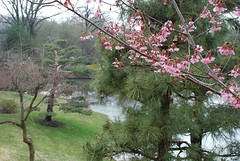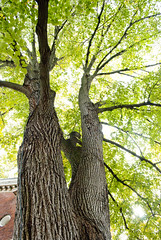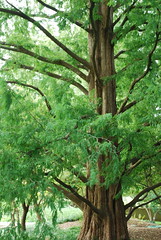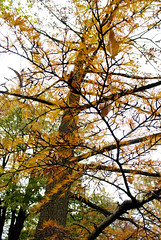
Although the trees of the Missouri Botanical Garden might seem to be an anonymous backdrop for the luscious plants nearby, they are in reality a garden unto themselves. They do not appear where they are by happenstance. They were planted with the same scrupulous attention to design and botanical diversity as the Garden’s myriad flowers and shrubs, and are an integral part of the Garden. Some of the trees are commonplace; others rare. Many carry a historical message. Others burst into eye-catching bloom at certain times of the year. Together, they form a garden within a garden, and each tree has its own story to tell of its botanical or historical interest, as noted on the interpretative sign it bears noting its history.

The Garden was virtually treeless when Henry Shaw began it in 1859 on the Missouri prairie. Now there are trees everywhere. There are 4,873 trees on Garden grounds, representing 1,096 unique taxa and 624 unique species.
There are remnants or descendants of trees planted by Shaw himself or his staff a century ago. Shaw planted Osage orange trees (Maclura pomifera) in the 1860s to line the carriage trail leading to his country home, Tower Grove House. Some of those trees or their offspring still stand behind the Climatron® conservatory and within the Doris I. Schnuck Children’s Garden, which opened in 2006. Although much of the original route is gone, with imagination you can trace the trail followed by Shaw and his guests.
The Garden has completed a project to draw a core of wood from representative trees and count the rings to determine its age. The oldest tree in the Garden is a bald cypress tree (Taxodium distichum) just south of Shoenberg Fountain near the Administration Building, thought to be planted around 1874. Tall and stately, this tree was probably part of Shaw’s arboretum, which he personally began in 1861 in a project that marked one of the earliest tree-planting efforts in the Garden.
More bald cypress are scattered throughout the Garden, with two rows by the lily pools between the Climatron and Spink Pavilion. Their characteristic of dropping leaves each winter – unusual among conifers, which generally are evergreens – may have saved the large trees. Leafless in the winter, they escaped the pollution during St. Louis’s coal-burning days when coal smoke killed nearly all the evergreen conifers on the Garden grounds.

The tallest tree in the Garden is a pin oak (Quercus palustris) in the Mausoleum, measuring 125 feet tall in 2011. Another large tree in the area is a white basswood (Tilia heterophylla) by the Museum Building, near the Tower Grove House. It is one of two trees in the Garden declared by the Missouri Department of Conservation as a “Missouri State Champion Tree,” a designation marking the largest of the species in the state. According to the state, the basswood is 103 feet tall and 12.4 feet or 149 inches in circumference. In 2009, the basswood received National Champion status. The other Missouri champion in the Garden is right across the path: A possumhaw (Ilex decidua).
There are trees captivating for their showy blossoms, like the cherry trees near the Japanese Garden. Other bloomers include flowering crab apples, dogwood, redbuds and white redbuds and magnolias.

Some trees are noteworthy because they are simply striking to behold. One such tree is a huge Scotch elm (Ulmus glabra) just west of Tower Grove House. Based on the coring project, this elm dates to 1913. The huge tree, with its gnarled trunk, has branches so large and heavy that some have to be supported by cables.
Another is a very stout ginkgo (Ginkgo biloba) by the Gate House. The species represents an evolutionary line that originated perhaps 280 million years ago, long before the earliest-known mammals and birds. This ginkgo was possibly purchased by Henry Shaw in 1861. Ginkgos were popular in America for their beauty, novelty, biological and historical interest and tolerance of unfavorable conditions, despite the foul odor of its seeds.

To view a “living fossil,” see the Shaw’s Legacy® Dawn Redwood (Metasequoia glyptostroboides, ‘Raven’) trees near the Lehmann Building to the west of Tower Grove House. A particularly attractive specimen, it was vegetatively propagated to retain unique characteristics including its extremely uniform pyramidal form with a low branching habit; deeply furrowed, convoluted, buttressed bark; and fast growth rate. This tree was unknown except through fossil records until 1941, when it was discovered growing in Asia by scientists who noticed a curious conifer. But Japan and China were at war, and the scientists who independently discovered the tree had to wait until the end of World War II before sharing information that led them to conclude the fossil did indeed live. The Missouri Botanical Garden’s specimens came from seeds received 1947, which led to their planting by the Lehmann Building.

An example of an unusual tree is the golden larch (Pseudolarix amabilis) by the Museum Building. It is the offspring of two trees that were in front of the Chinese Pavilion at the 1904 World’s Fair. The trees, long forgotten, were re-discovered in 1953 when a woman wore a sprig from a tree in her yard in a corsage to a social event at the Garden. Her corsage created quite a stir, with the sprig identified as the rare golden larch. It was further learned that a previous owner of the woman’s home had been a hostess at the World’s Fair, and had handed out sprigs of the larches to visitors. The fact that the larches are “one generation from the 1904 World’s Fair makes it very significant,” said Tynan.